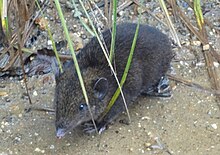Hylomys

| Hylomys[1] | |
|---|---|
 | |
| Bornean short-tailed gymnure | |
| Scientific classification | |
| Domain: | Eukaryota |
| Kingdom: | Animalia |
| Phylum: | Chordata |
| Class: | Mammalia |
| Order: | Eulipotyphla |
| Family: | Erinaceidae |
| Subfamily: | Galericinae |
| Genus: | Hylomys S. Müller, 1840 |
| Type species | |
| Hylomys suillus S. Müller, 1840 | |
| Species | |
| See text | |
Hylomys is a small genus of the family Erinaceidae.[2] Hylomys species, like all species in the subfamily Galericinae, are known as gymnures or moonrats. Their closest relatives include the fossil Lantanotherium and Thaiagymnura and the living Neotetracus and Neohylomys. Members of this genus are found in Southeast Asia and Eastern Asia.
Species
[edit]Traditionally, only three extant species were recognized, though others had been described. More recently, five additional species are recognized.[3]
- Hylomys dorsalis O. Thomas, 1888 (Bornean short-tailed gymnure)
- Hylomys macarong Hinckley, Lunde, & Hawkins, 2023 (Dalat gymnure)
- Hylomys maxi Sody, 1933 (Max's short-tailed gymnure)
- Hylomys parvus Robinson & Kloss, 1916 (Dwarf gymnure)
- Hylomys peguensis Blyth, 1859 (Northern short-tailed gymnure)
- Hylomys suillus S. Müller, 1840 (Javan short-tailed gymnure)
- Hylomys vorax Hinckley, Lunde, & Hawkins, 2023 (Leuser gymnure)
- †Hylomys engesseri Mein & Ginsburg, 1997 (fossil)
References
[edit]- ^ Hutterer, R. (2005). Wilson, D.E.; Reeder, D.M. (eds.). Mammal Species of the World: A Taxonomic and Geographic Reference (3rd ed.). Johns Hopkins University Press. p. 218. ISBN 978-0-8018-8221-0. OCLC 62265494.
- ^ Wilson, D. E.; Reeder, D. M., eds. (2005). Mammal Species of the World: A Taxonomic and Geographic Reference (3rd ed.). Johns Hopkins University Press. ISBN 978-0-8018-8221-0. OCLC 62265494.
- ^ Hinckley, A.; Camacho-Sanchez, M.; et al. (2023). "An integrative taxonomic revision of lesser gymnures (Eulipotyphla: Hylomys) reveals five new species and emerging patterns of local endemism in Tropical East Asia". Zoological Journal of the Linnean Society: zlad177. doi:10.1093/zoolinnean/zlad177.
